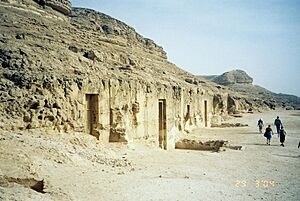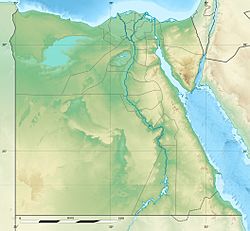Beni Hasan facts for kids

The tombs of Khety and Baqet III
|
|
| Coordinates | 27°56′N 30°53′E / 27.933°N 30.883°E |
|---|---|
| Type | Tombs |
Beni Hasan (also called Bani Hasan) is an ancient Egyptian burial ground. It is about 20 kilometers (12 miles) south of the modern city of Minya. This area is part of Middle Egypt, located between Asyut and Memphis.
Most of the tombs at Beni Hasan were used during the Middle Kingdom period. This was a time in ancient Egypt from about 2100 to 1700 BCE. Some older burials from the Old Kingdom have also been found here.
South of the main burial area, there is a temple built by two famous pharaohs, Hatshepsut and Thutmose III. This temple was made for the local goddess Pakhet. People call it the Cave of Artemis. This is because the Greeks thought Pakhet was similar to their goddess Artemis. The temple is also built underground.
Contents
Exploring the Ancient Tombs
During the Middle Kingdom, important leaders of different regions were buried in special tombs. These tombs were often carved right into the rock cliffs. Beni Hasan is one of these places.
The way the government worked changed during the 12th Dynasty. Before this, local governors, called nomarchs, often passed their power down to their children. This meant they were very powerful and didn't always need the king's approval. But in the 12th Dynasty, the king started to have more control. He would appoint or approve these governors.
Where the Tombs Are Found
Beni Hasan has 39 ancient tombs from the Middle Kingdom period. These belonged to the nomarchs of the Oryx nome, which was a specific region of Egypt. The tombs are on the east side of the Nile River, carved into the cliffs.
There are two main burial areas here: an upper area and a lower area. The most important people were buried higher up on the cliff. This showed their high status.
In the lower burial area, there are 888 simpler tombs. These were excavated by John Garstang. Most of these tombs had a shaft that went down into the ground. At the bottom, there was a small room for the coffin and other burial items.
Tombs of the Elite
In the upper burial area, the most important people built impressive tombs. These tombs showed their power as rulers and officials of the Oryx Nome. These large tombs were carved into the limestone cliffs. They are arranged in a line from north to south.
The basic design of these important tombs included an outer courtyard. Then, there was a room carved into the rock with pillars, often called a chapel. Inside this room, a shaft led down to the actual burial chamber.
Some of the larger tombs have special writings about the person buried there. They also have colorful paintings showing daily life and battles. These paintings are very famous for how well they were done. Today, many of these paintings are not in good condition. But in the 1800s, copies were made of some of them. The famous archaeologist Howard Carter even painted some of them when he was a teenager in 1891.
Famous Tombs to See
Out of the 39 tombs, four are open for visitors to explore. Here are some of the most well-known tombs:
- Tomb 2 – This is the tomb of Amenemhat, also known as Ameny. He was a nomarch during the time of Pharaoh Senusret I. You can visit this tomb.
- Tomb 3 – This tomb belongs to Khnumhotep II. It is famous for its paintings that show groups of Semitic traders visiting Egypt. This tomb is also open to the public.
- Tomb 15 – This is the tomb of Baqet III. It is special because it has detailed pictures of different wrestling techniques. You can visit this tomb.
- Tomb 17 – This tomb is for Khety, who was a nomarch during the 11th Dynasty. He was the son of Baqet. This tomb is known for showing what might be ancient ball games. It is also open to the public.
Other tombs, like Tomb 4 (Khnumhotep IV), Tomb 13 (Khnumhotep), Tomb 14 (Khnumhotep I), Tomb 21 (Nakht), Tomb 23 (Netjernakht), Tomb 27 (Ramushenti), Tomb 29 (Baqet I), and Tomb 33 (Baqet II), are currently closed to the public.
See also
- List of ancient Egyptian towns and cities






